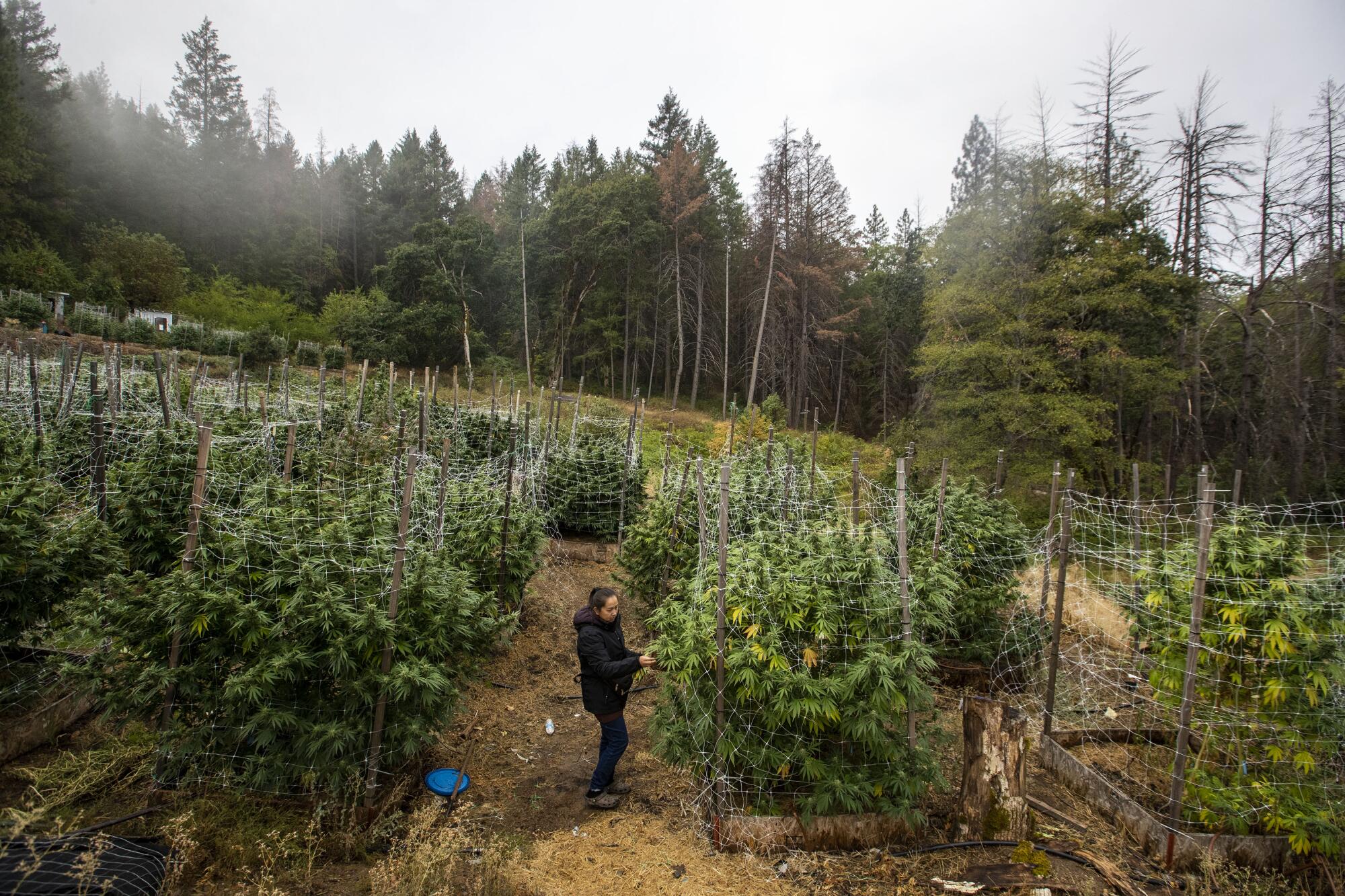
DOUGLAS CITY, Calif. — Xong Vang and Chia Xiong arrived in Douglas City, a town of the Gold Rush era, hoping to make good from the next big California boom.
After the state legalized cannabis in 2016, they joined a wave of newcomers settling in this mountainous, lushly forested Northern California region known to produce some of the world’s best weed. They believed that here in remote Trinity County, they could find their own “Green Rush,” growing pot for what was promised to be a profitable legal market.
Today, the couple are struggling to keep their 3.4-acre farm going. They live in a trailer on the side of a mountain, where they eke out a modest farm life, raising pigeons for eggs. They worry about providing for their children amid what seem like endless delays to regain licenses needed to legally cultivate their cannabis crop.
Their plight is so desperate that Vang and Xiong have resorted to a path they tried to avoid: growing without a county permit.
“People say you live paycheck to paycheck, but there’s no paycheck to live off of,” Xiong said, standing amid budding plants nestled on the slopes of a rugged peak.
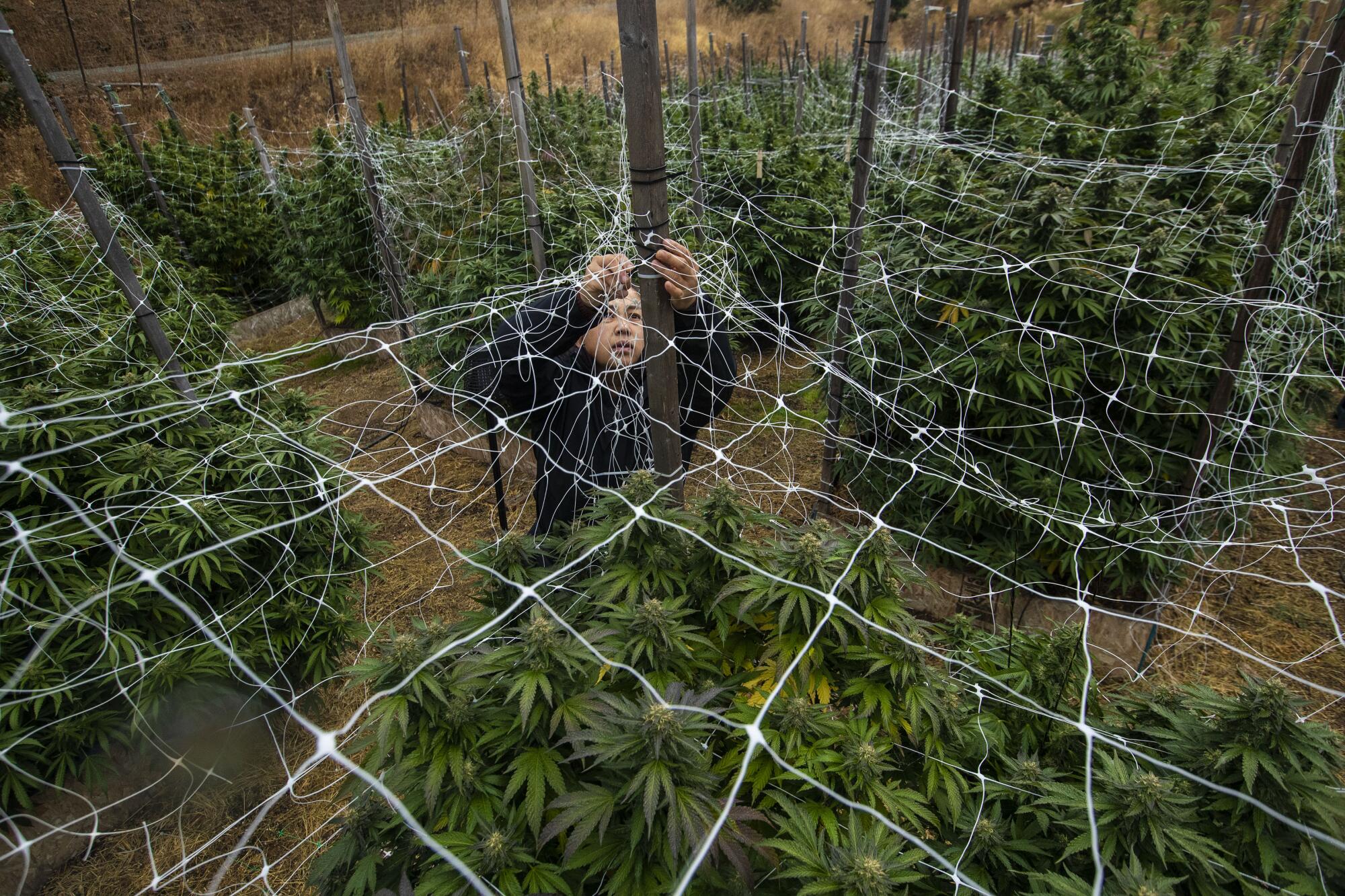
They are among hundreds of local cannabis growers entangled in a legal impasse that has kept many from planting and led some to consider joining a thriving underground economy that was supposed to decline after cannabis was legalized by Proposition 64.
Boom-and-bust cycles are part of this county’s history, from gold mining in the 1800s to, a century later, the crash of the logging industry. Legal cannabis was going to be a lifeline for residents. But that promise has quickly collapsed.
Part of the tri-county “Emerald Triangle” in Northern California, this expanse of forests and hidden canyons has the ideal climate for cannabis: hot days and cool summer nights. It’s described by locals as the Napa Valley of weed. If any place in California would have been expected to flourish after cannabis was legalized, it was Trinity, where the crop’s roots were sown during the counterculture movement of the 1960s.
But the legalization measure, which in Trinity won by only a handful of votes, was polarizing from the start. Critics of licensed farming worried that an influx of commercial growers would wreak havoc, causing ecological destruction and eroding the community’s sense of safety and trust. Proponents touted the benefits of tax revenue and higher property values from cultivation licenses.
Following a lawsuit, a Superior Court judge last year invalidated nearly all licenses that had been awarded, ruling that the county approved them without requiring growers to document potential environmental impacts and measures to prevent harm.
By early November, just 44 licenses had been reapproved, and about 300 farmers, including Vang and Xiong, are still waiting.

In the meantime, some have let their lands lie fallow, while others have chosen to produce illegal harvests, avoiding the fees, taxes and red tape associated with obtaining a license.
Some illegal growers have diverted streams, poisoned the land with toxic chemicals, destroyed wildlife habitat and threatened people who stray near their plantings.
County leaders say they understand the pain of growers and are working to bring on staff to speed up environmental reviews.
Keith Groves, a member of the county Board of Supervisors who sat on the ad hoc cannabis committee, bristled at suggestions that Trinity’s licensing program is more dysfunctional than others in the state.
“There’s not a program that isn’t in shambles,” he said.

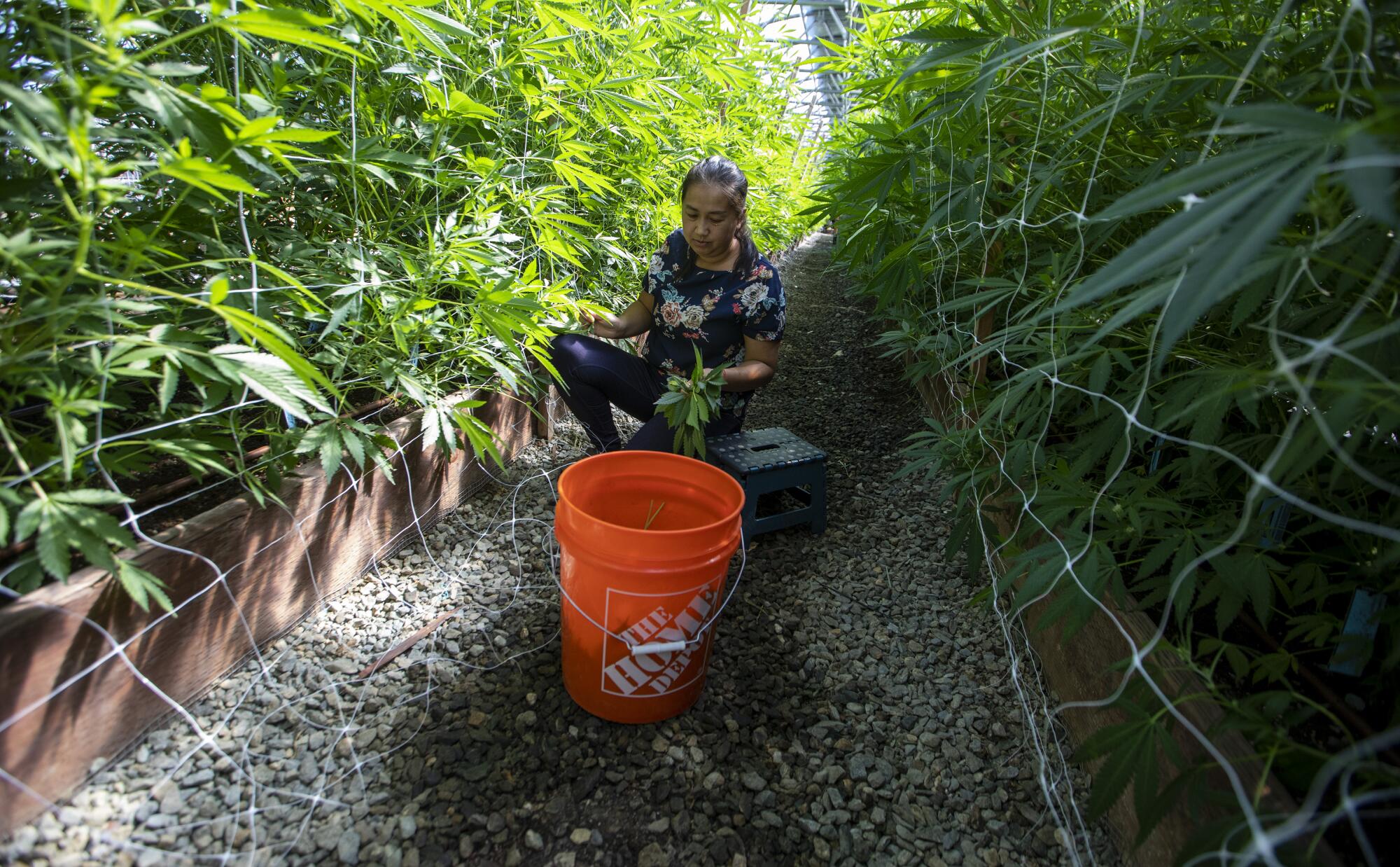
Pioneers in search of riches have long flocked to this area.
The Gold Rushers arrived in the mid-19th century, as word spread of men striking it rich by extracting the metal with their bare hands. Later, hydraulic mining washed entire hillsides into the cascading Trinity River.
Decades afterward, industrial logging thinned lush pine forests, and timber companies fought environmentalists over the fate of spotted owls in what became known as the timber wars. At its peak, the timber industry was a major employer, with 28 sawmills; today, only one remains open.
Cannabis supporters believed legalization would bring an end to the cycle of boom and bust.
The regulated market was supposed to provide a stable economic foundation for this county with a population of about 16,000 that is among the poorest in California (with a poverty rate of 18%, significantly more than the state average), while ousting the unsavory characters who had abused the land and sowed fear among residents.
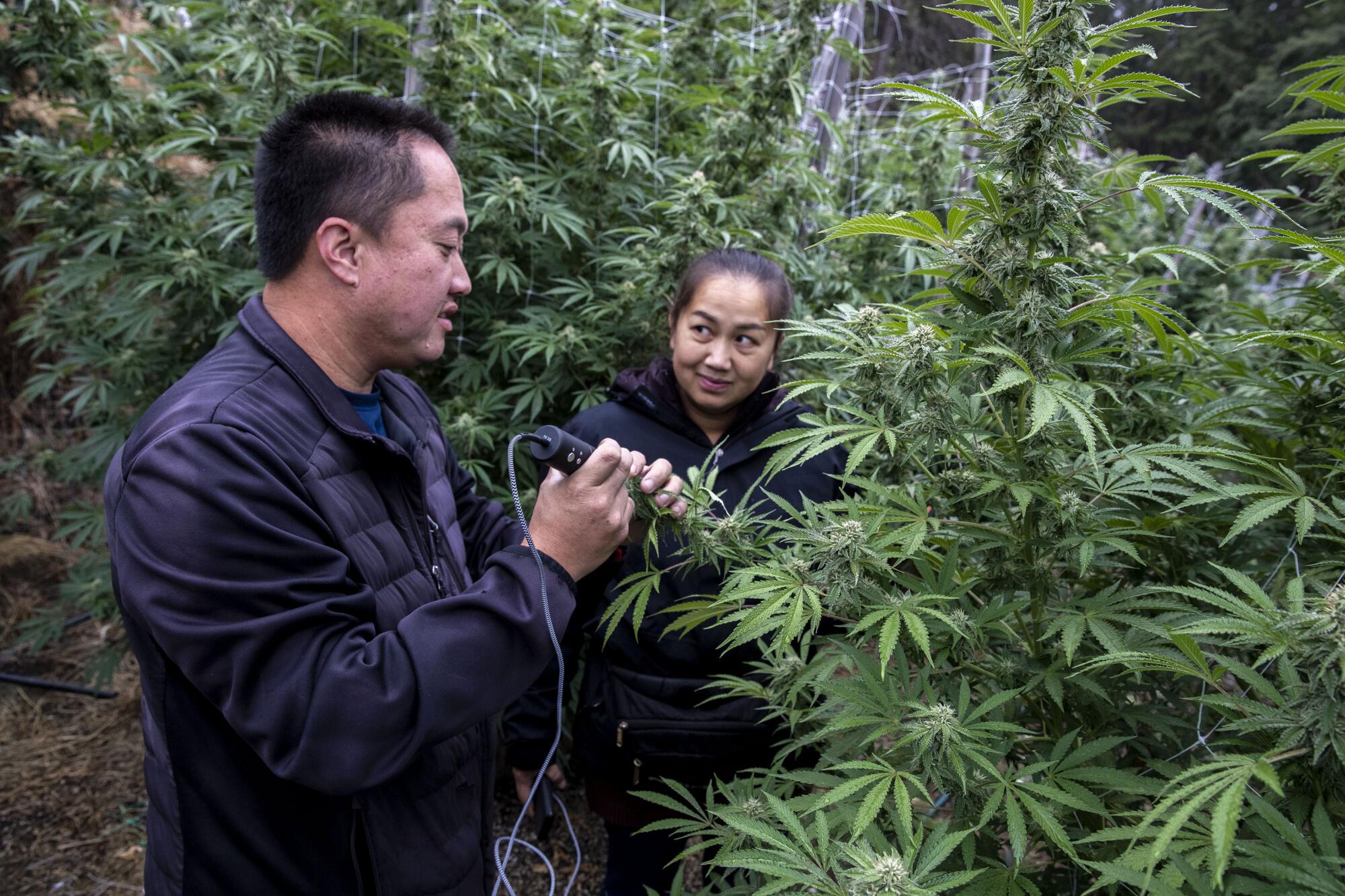

This year, Vang and Xiong’s plants are much smaller than usual — only a few feet tall just before harvest. The couple hold state licenses that allow each to grow up to 10,000 square feet of canopy — but they held off planting out of fear that the county would issue them fines that could total thousands of dollars a day. (In California, cannabis businesses must have both state and local licenses to operate commercially.)
They say they submitted the required environmental impact reports, but months later, the county hasn’t granted them permission to grow. They missed the early stages of the cultivation season as they waited. They decided to roll the dice, risking the penalties, and planted late into the season.
Down an abandoned section of old Highway 299 stands a small, temperature-controlled clone room housing plant cuttings of strains grown on the farm: Purple Punch, Rainbow Belt, Tropical Cookie.
Vang, 38, and Xiong, 37, are part of an enclave of 11 Hmong families, among the hundreds of people who moved to Trinity County hoping to grow commercial weed.
They quickly adapted to their new lives, residing in a mobile home overlooking the green, rolling bluffs.

They and other Hmong farmers have pleaded with county officials to speed up the licensing process. Some say they are running low on food as their land lies bare of plantings.
Financial losses from illegal operations and depressed prices have been “incalculable” for farmers, said Adrien Keys, president of the Trinity County Agriculture Alliance, an association of about 100 cultivators.
Many, he said, invested hundreds of thousands of dollars in their businesses and in a county system that is unreliable and threatens to push away manufacturers, distributors and others who rely on products from the region.

“If we lose our business, we lose our homes,” said Keys, 53.
A farmer who has been growing illegally for two decades said he spent thousands of dollars to become legitimate but ultimately gave up. The farmer spoke on condition of anonymity because he fears retribution from county authorities.
He’s growing 70 plants outside Weaverville, in a rugged canyon that gets plenty of sun for his crop but has heavy foliage that obscures the view of law enforcement aircraft overhead. A native of Northern California, he has been growing weed in Trinity County since the late 1990s.
In 2017, he decided to become a legal grower and borrowed $180,000 against his home to pay for grading the land and consulting and attorneys fees. He ran into bureaucratic hurdles, including county staff losing his application and asking him to reapply, he said. But the final straw came when the court’s ruling forced the county to invalidate all cannabis licenses.
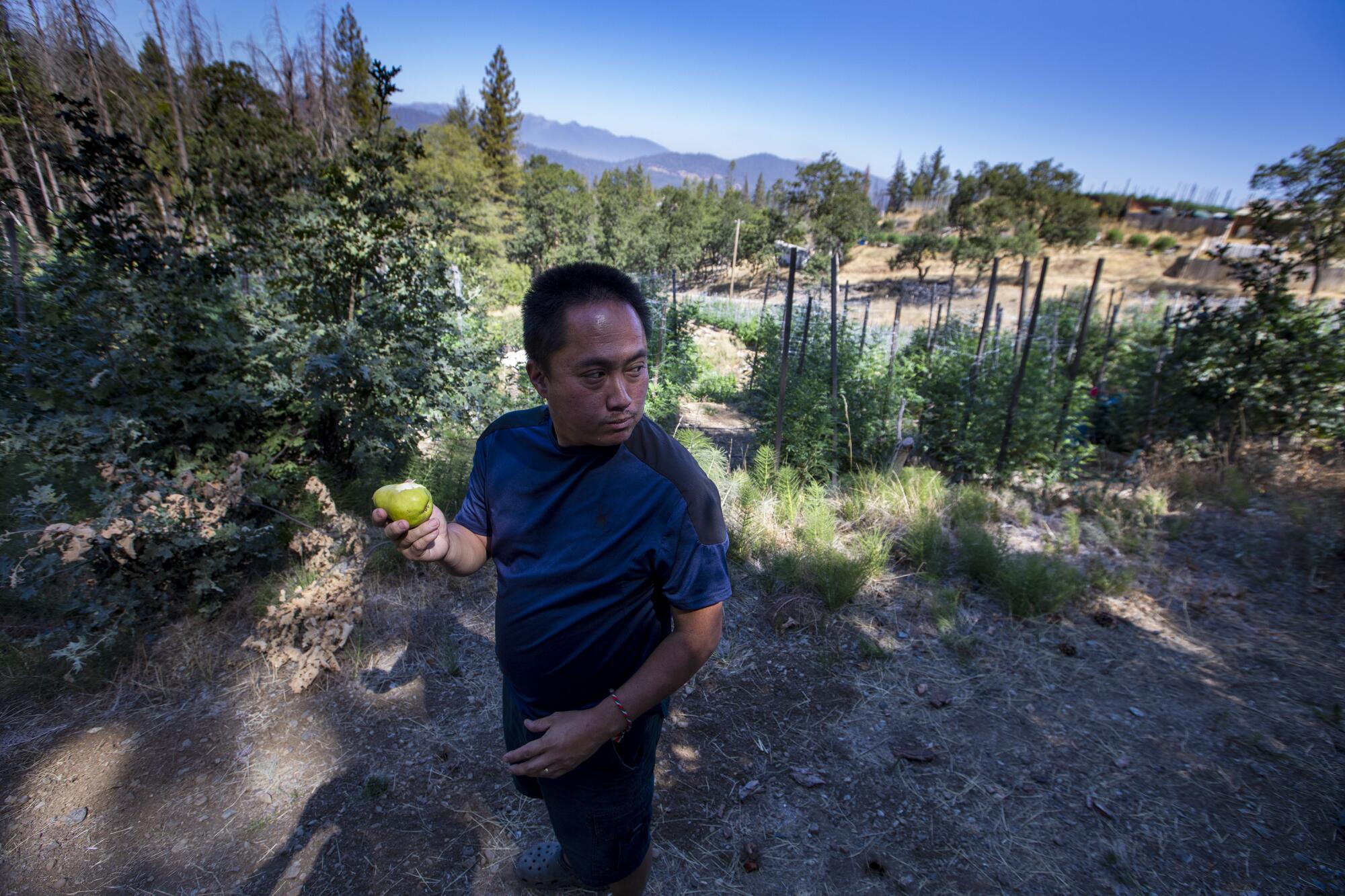
“It’s a complicated mess,” the farmer, 57, said. “The illegal market is better. We don’t have to pay the fees and taxes.”
Michael Polson, a research scientist with the Cannabis Research Center at UC Berkeley, noted the impact of Trinity County’s chaotic cannabis program.
“The legitimacy of the licensing system has been undermined,” said Polson, who has studied how the illegal market has changed in Trinity since legalization.
Interviews with residents and local officials and a Times review of county records reveal the repercussions of an estimated 3,000 illegal cultivation sites. Satellite images show how one hot spot, Post Mountain, has been nearly stripped bare of its once-pristine forest, as if the land were going bald.
Reports of intimidation and threats abound.
A lone deputy on patrol was confronted by a truck full of men, their faces hidden by bandannas, carrying assault rifles. The deputy retreated and fled, according to Jeremy Brown, a member of the county’s Board of Supervisors.
In another instance, a man leaving his home made a wrong turn and was forced to reverse his vehicle more than a quarter of a mile uphill by an illegal cultivator, who proceeded to “cuss, yell, flip the bird to both myself and my wife,” the man told county officials in an email.
The illegal farm had been cited, but it made no difference; the owners only brought in more plants.
California’s legalization of recreational cannabis in 2016 ushered in a multibillion-dollar industry estimated to be the largest legal weed market in the world. But many of the promises of legalization have proved elusive. In a series of occasional stories, we’ll explore the fallout of legal pot in California.
Local law enforcement agencies are outnumbered and outgunned. Two sheriff’s deputies are assigned to cannabis enforcement — only one of them full time — in an area larger than Delaware.
The office of Trinity County Dist. Atty. David Brady has no investigators, just a handful of staffers. Brady operates from the upper floor of the courthouse, a boxy, maroon building in Weaverville that was constructed as a hotel and saloon back when the county was settled by those heading west to seek better lives and, if lucky, fortunes.
Weaverville is the county seat, nestled in the shadow of snowcapped mountains, and it evokes those pioneer days, with a historic district lined with wood-and-brick buildings dating to the 1850s. The restaurants and other businesses bear names evoking the Gold Rush, and almost nothing around town suggests that this land is the heart of cannabis country.
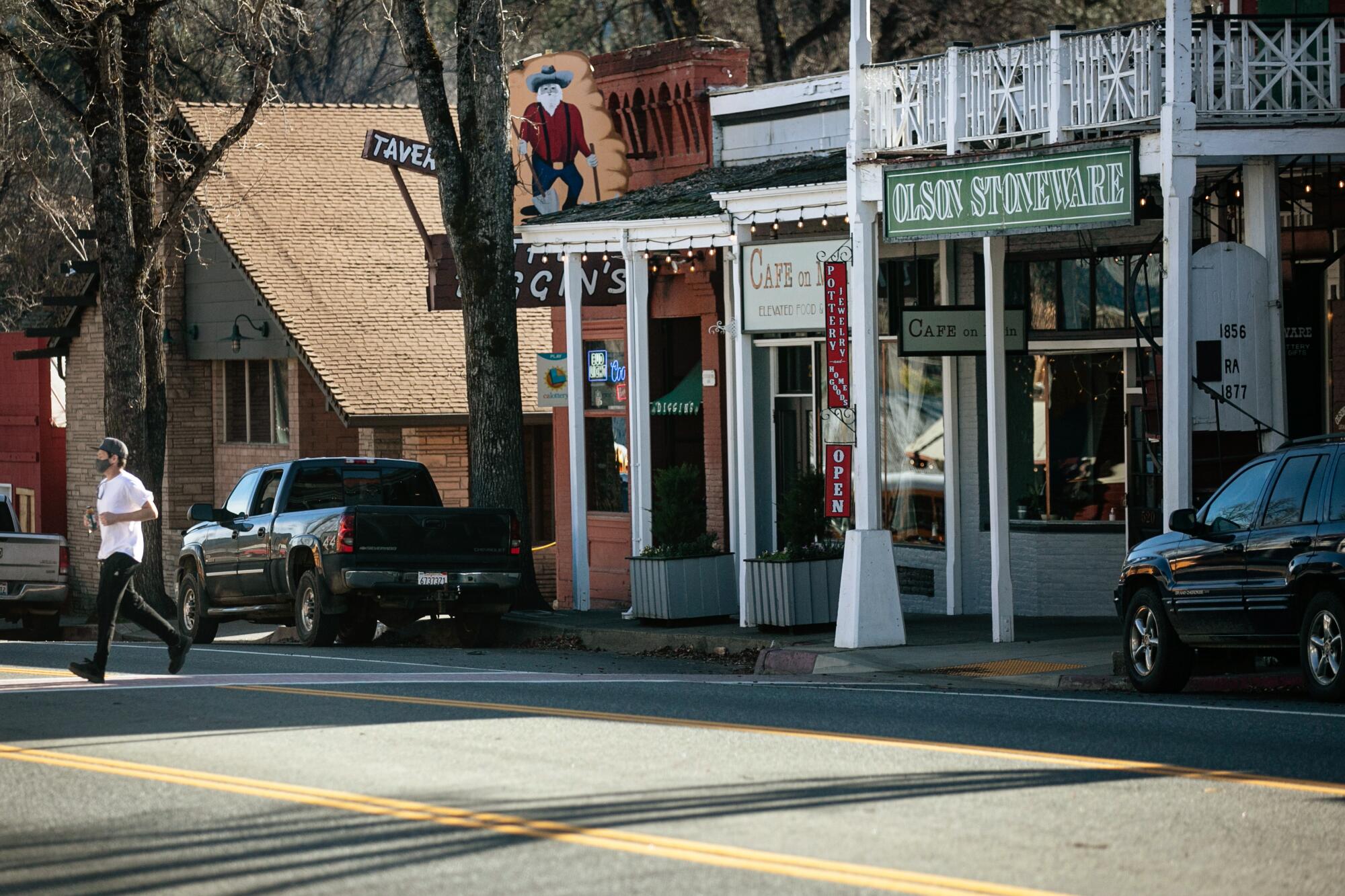
Painted on the wooden sign for the Diggins, Weaverville’s old tavern, is a white-bearded gold miner holding his shovel and pike. Down the street is the Nugget, a diner.
Limited resources for law enforcement and provisions in Proposition 64 that downgraded large-scale illegal cultivation from a felony to a misdemeanor have undercut regulation of illicit grows, Brady said.
“I feel like Sisyphus, for Christ’s sake,” he said of battling the illegal trade, only to see it mushroom.
The theft of water from tributaries and streams is among the most serious threats.
“The environmental damage we are dealing with is horrendous,” Brady said.
In late 2018, the California Department of Fish and Wildlife found 900 plants and more than 5,000 pounds of cannabis during a raid on an illegal cultivation site. More than 30 suspects were detained. Some were armed and had bulletproof vests; two had fake police badges.
The operation was diverting water from the South Fork Trinity River and threatening the breeding habitat of steelhead trout, chinook salmon and the foothill yellow-legged frog, state officials said.
Grading for illegal operations has discharged sediment into streams. Petroleum products and trash have made their way into watersheds; officials have discovered dangerous rodenticides and pesticides as well. Since 2019, the Department of Fish and Wildlife has been involved in 187 enforcement operations in Trinity County, removing 645,117 marijuana plants.

Many Trinity residents express pessimism about their economic future, even as they’re reverent about the place’s natural beauty. “God’s country,” some call it.
With wildfires increasingly common because of climate change, the tourism industry that supports many has suffered. In August, smoke hung in the air as distant fires threatened life and property.

On Highway 3 heading to Hayfork, an occasional trailer comes into view; furniture and other belongings are strewn across the grass, seemingly abandoned.
The old logging town of just over 2,000 residents, about 40 miles west of Redding, still boasts working ranches raising hay and cattle. “Trimmigrants” — outsiders who come for seasonal work clipping cannabis plants — often grab a drink at Ropin Rhonda’s Saloon, a rustic watering hole named for the woman who manages the bar and expertly roped cattle in her younger years.
Hayfork native Marie Petersen works as a cannabis licensing consultant from a commercial office. The building is on a main road, but there has been little activity lately.
Standing outside the door, she pointed to a number of businesses that recently closed.
“It’s been a terrible impact,” Petersen said about the licensing crisis.
The Northern Delights coffeehouse was once a gathering place for Hayfork residents, Petersen said, with dance nights and concerts. In August, it sat empty.
John Letton leads the Trinity Action Assn., a group of residents that filed the lawsuit over environmental impact reviews, shutting down legal growers. He is a retired Trinity County Superior Court judge who, as a young attorney in the 1960s and 1970s, lived in San Francisco “and survived,” as he puts it.
Letton migrated to the area during the “back to the land” movement of that era, when many counterculture urbanites yearned to ditch consumerism, escape the social upheaval tied to the Vietnam War and reconnect to nature.
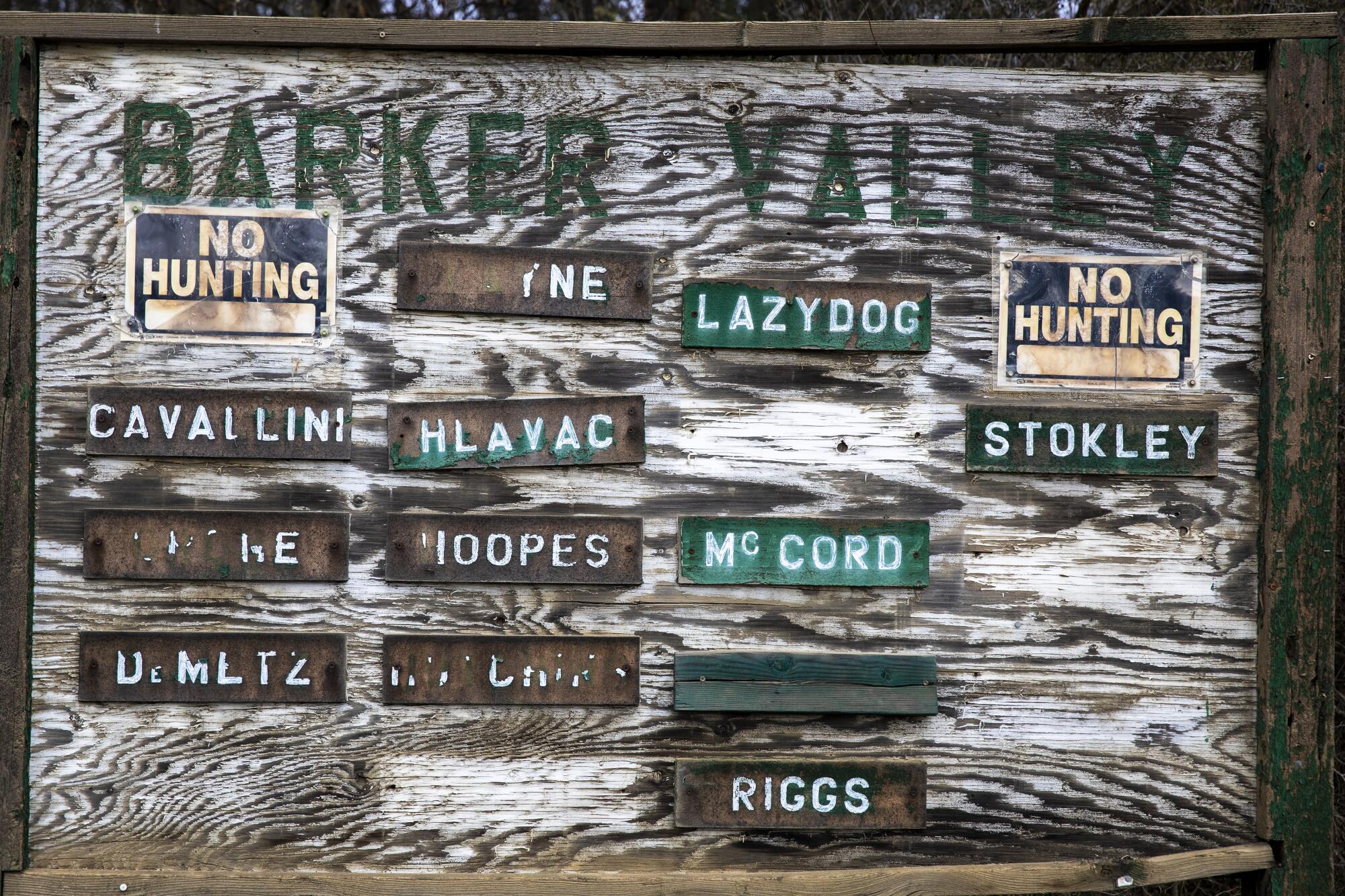
Today, he and his group are seen by many in the pot industry as archvillains, part of the older Trinity County power structure that’s anti-cannabis and determined to halt change, no matter the cost.
Proposition 64 passed by only six votes in Trinity County, and the issue remains deeply controversial.
Letton says he’s not opposed to pot — he used it after he was diagnosed with cancer and believes it is a helpful therapy. He says his goal was not to have all licenses canceled but to limit the environmental harm caused by some growing operations.
He acknowledges that there are “some people who really got screwed” but says the idea that cannabis can be the foundation of the local economy, with “bud and breakfasts” and tasting events, is a pipe dream.
Some legalization boosters envisioned a wellspring of riches from cannabis that could help pay for college, expand hospital and mental health services and lead to skyrocketing property values.
Instead, Trinity residents say, a rural, “Mayberry” way of life in which people left their keys in their cars has been ruined. The influx of outsiders to cultivate weed has left longtime residents scared and suspicious.

“What are the neighbors up to?” asked Richard Tippett, a former county official who handled pot licensing. “Who knows?”
Experts who researched the local weed market said Trinity officials focused on potential revenue but gave little thought to technical details that exposed the county to legal challenges.
“Their eagerness to accommodate as many licenses as possible and get the taxes shot them in the foot, because they rushed it,” said Dominic Corva, a sociology professor and director of the Cannabis Studies Program at Cal Poly Humboldt.
“There really is a culture war in Trinity County about cannabis,” Corva said.

Grower Terry Mines has been warring with Trinity officials for years. He tried to develop a cannabis storage and distribution facility but was denied county approval in 2020. Thus far, the county has approved licenses only for cultivation, and there are no legal dispensaries.
The county cited him for growing weed without a license, but he ignored that. So far, there has been no sheriff’s raid or other action from law enforcement, and his state license to cultivate remains active.
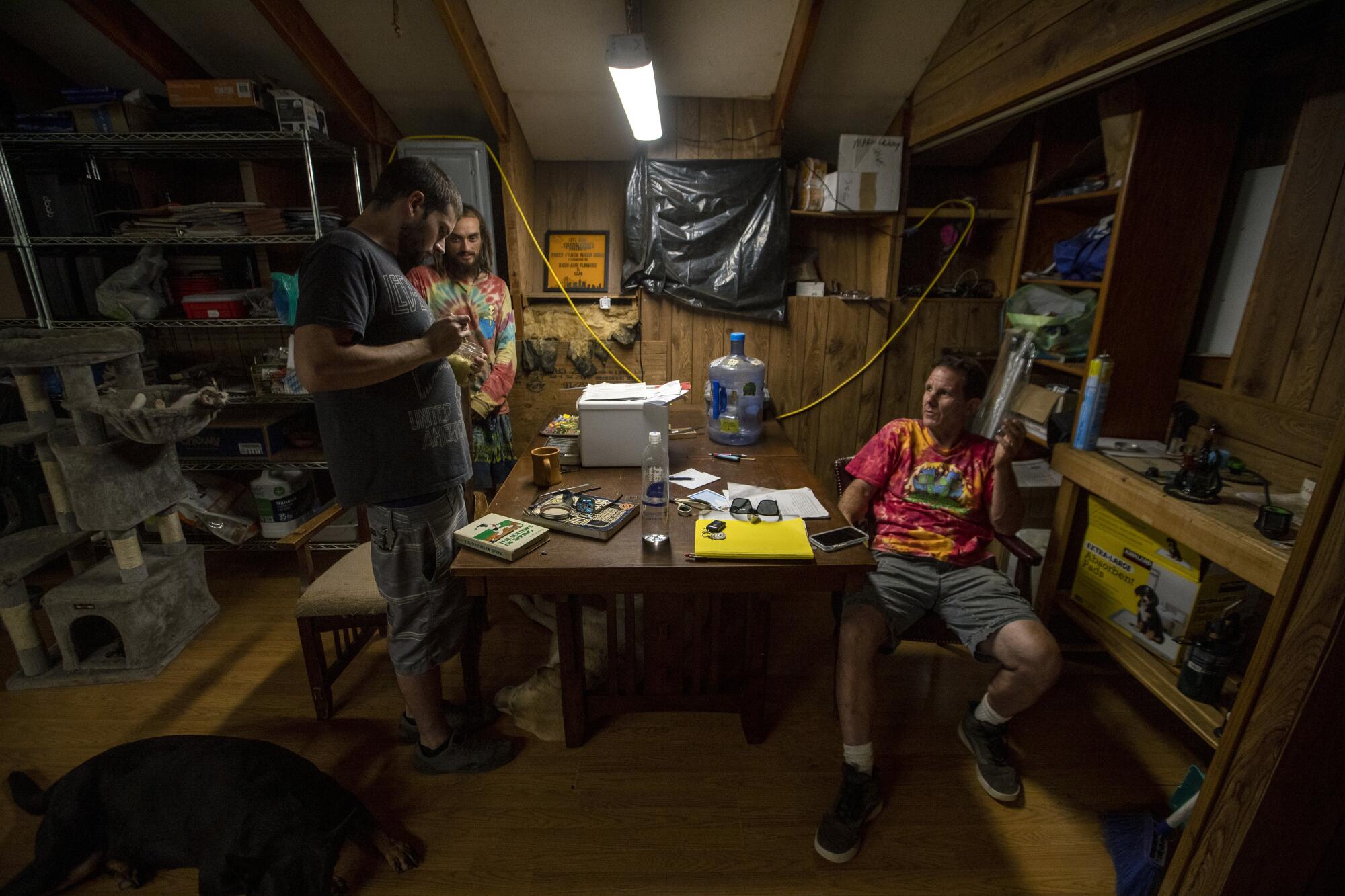
He’s aggressive and outspoken, traits he says have been key to making his way in the pot business. He has smoked weed since he was 11, he said, before progressing to the trade as a small-bag dealer in high school.
His move to Trinity County in 2009 coincided with the Green Rush. On a hillside in Junction City, 16 employees of his business, Hash and Flowers, breed, grow, harvest and refine cannabis flower into a high-dose paste called ice water hash, or rosin. They also breed plants and create strains. This year’s cross: Cran-Skittles and Banana Hanks.
The plants this season grew to 20 feet, a weed jungle looming above workers. The buds end up in the “spaceship,” a sterile cluster of rooms covered in a shiny, silver tarp, where THC, the chemical that gets you high, is extracted into hash. Some of that is further refined into an oil and embedded into vaporizing pens.
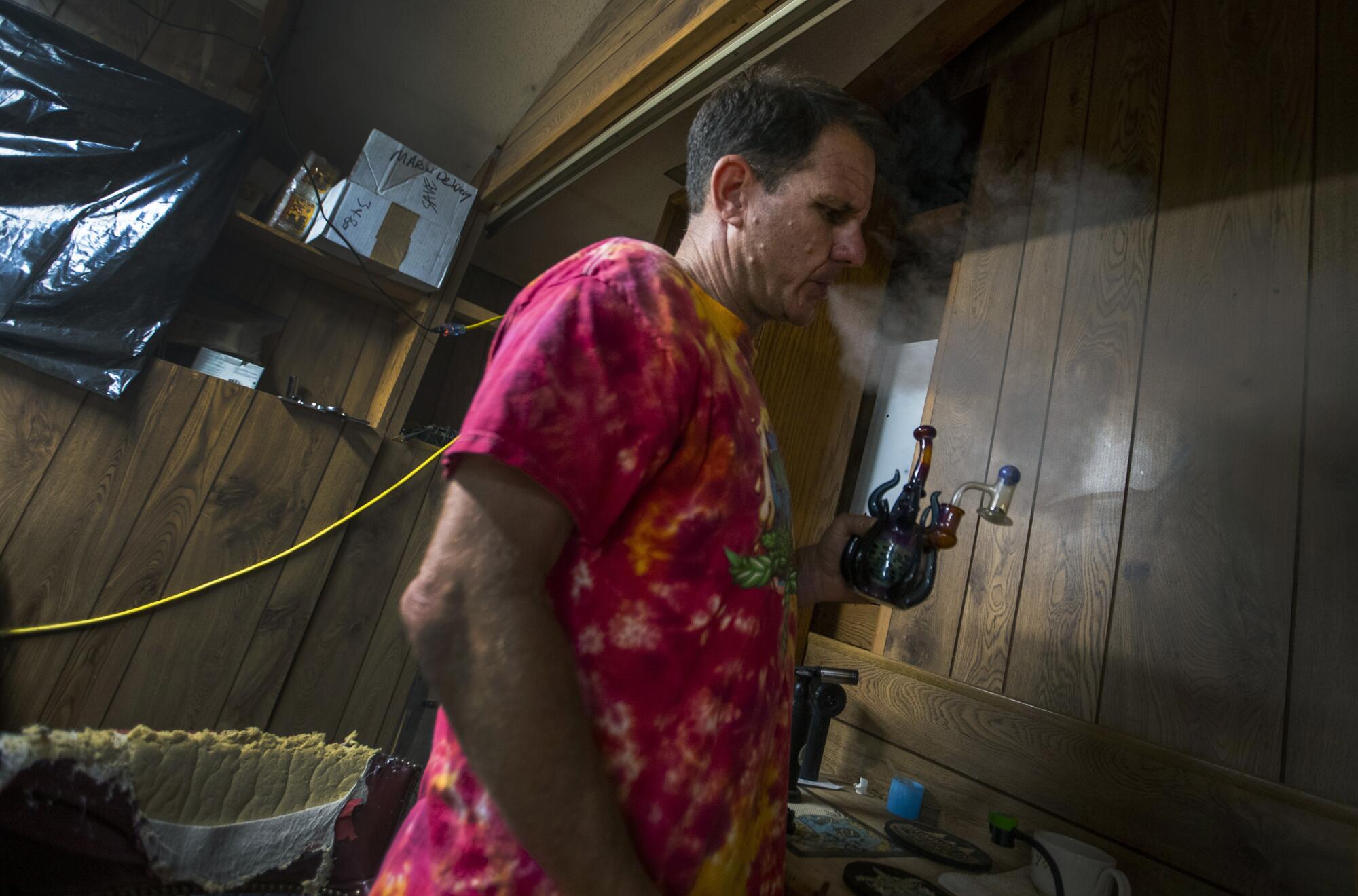
During a break, Mines pulled out a water pipe with a temperature gauge and waited until the heat was at the level for optimal THC consumption: 440 to 500 degrees Fahrenheit. He exhaled a plume of smoke, which briefly obscured a face gnarled by violence — part of his nose was bitten off during a brawl.
“The only thing that’s going to slow me down is a fire or Mother Nature,” Mines said.
Despite their woes, some in the community are betting that Trinity can rebound.
One hopeful sign: The Northern Delights coffeehouse has reopened. Hayfork is facing tough times, the new owner, Shawn Hill, acknowledged. But he expressed hope that the town would pull through and is making a long-term wager on the future.
“It’s about bringing a new attitude,” Hill, 37, said. “It’s almost like a game of poker. If you want to be at the final table, you gotta be able to handle the swings.”















